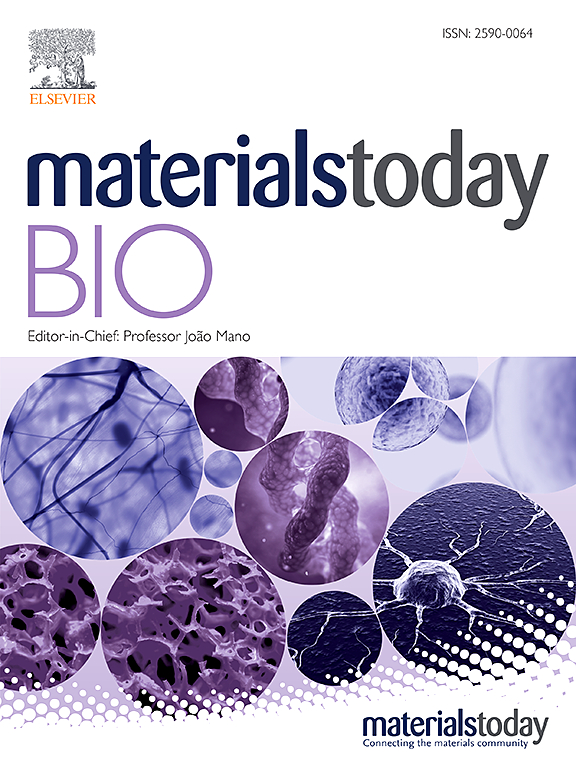Multifunctional layered microneedle patches enable transdermal angiogenesis and immunomodulation for scarless healing of thermal burn injuries
IF 8.7
1区 医学
Q1 ENGINEERING, BIOMEDICAL
引用次数: 0
Abstract
Thermal burn injuries induce substantial alterations in the immune compositions and anatomical structures in the skin, which are characterized by strong inflammatory responses and thick eschar formation on the wound surface. These traits challenge current treatment paradigms due to insufficient drug penetration into affected tissues and the unsatisfactory wound regeneration. Herein, we report a layered microneedle (MN) patch for addressing these challenges in burn injury healing. The MN patch features a core/shell structure with methacrylated gelatin (GelMA) encapsulated with human umbilical vein endothelial cell (HUVECs)-derived hypoxia-induced exosomes (EXO-H) as the bottom layer and sodium alginate (SA) containing naringin (Nar)-loaded CaCO3 nanoparticles (CaCO3@Nar) as the top layer. Upon administration onto thermal burn injury site, the MN patches enable transdermal drug delivery by perforating the eschar. The spontaneous degradation of CaCO3@Nar in the interstitial fluid triggers sustained Nar release to alleviate local inflammation and scavenge excessive reactive oxygen species (ROS). Meanwhile, EXO-H significantly promote the migration and proliferation of HUVECs and enhance their angiogenesis capacity to support scarless wound tissue regeneration. The MN patch in this work successfully promoted scarless healing of skin burn injuries on rat models, providing an approach for thermal burn treatment in the clinics.

多功能分层微针贴片实现透皮血管生成和免疫调节,促进热烧伤的无疤痕愈合
热烧伤会导致皮肤中的免疫成分和解剖结构发生重大改变,其特点是炎症反应强烈,创面形成厚厚的焦痂。由于药物不能充分渗透到受影响的组织,伤口再生效果也不理想,因此这些特征对目前的治疗模式提出了挑战。在此,我们报告了一种分层微针(MN)贴片,用于解决烧伤愈合中的这些难题。这种微针贴片具有核/壳结构,底层是甲基丙烯酸明胶(GelMA),其中包裹着人脐静脉内皮细胞(HUVECs)产生的缺氧诱导外泌体(EXO-H),顶层是含有柚皮苷(Nar)的 CaCO3 纳米颗粒(CaCO3@Nar)的海藻酸钠(SA)。在热烧伤部位给药后,MN 贴片可通过穿透焦痂实现透皮给药。CaCO3@Nar在间隙液中的自发降解会引发纳尔的持续释放,从而缓解局部炎症并清除过多的活性氧(ROS)。同时,EXO-H 能显著促进 HUVECs 的迁移和增殖,增强其血管生成能力,从而支持无瘢痕伤口组织再生。这项研究中的 MN 贴片成功促进了大鼠皮肤烧伤模型的无瘢痕愈合,为临床热烧伤治疗提供了一种方法。
本文章由计算机程序翻译,如有差异,请以英文原文为准。
求助全文
约1分钟内获得全文
求助全文
来源期刊

Materials Today Bio
Multiple-
CiteScore
8.30
自引率
4.90%
发文量
303
审稿时长
30 days
期刊介绍:
Materials Today Bio is a multidisciplinary journal that specializes in the intersection between biology and materials science, chemistry, physics, engineering, and medicine. It covers various aspects such as the design and assembly of new structures, their interaction with biological systems, functionalization, bioimaging, therapies, and diagnostics in healthcare. The journal aims to showcase the most significant advancements and discoveries in this field. As part of the Materials Today family, Materials Today Bio provides rigorous peer review, quick decision-making, and high visibility for authors. It is indexed in Scopus, PubMed Central, Emerging Sources, Citation Index (ESCI), and Directory of Open Access Journals (DOAJ).
文献相关原料
公司名称
产品信息
索莱宝
Cell Counting Kit-8 (CCK-8)
阿拉丁
Sodium alginate (SA)
阿拉丁
Sodium alginate (SA)
 求助内容:
求助内容: 应助结果提醒方式:
应助结果提醒方式:


